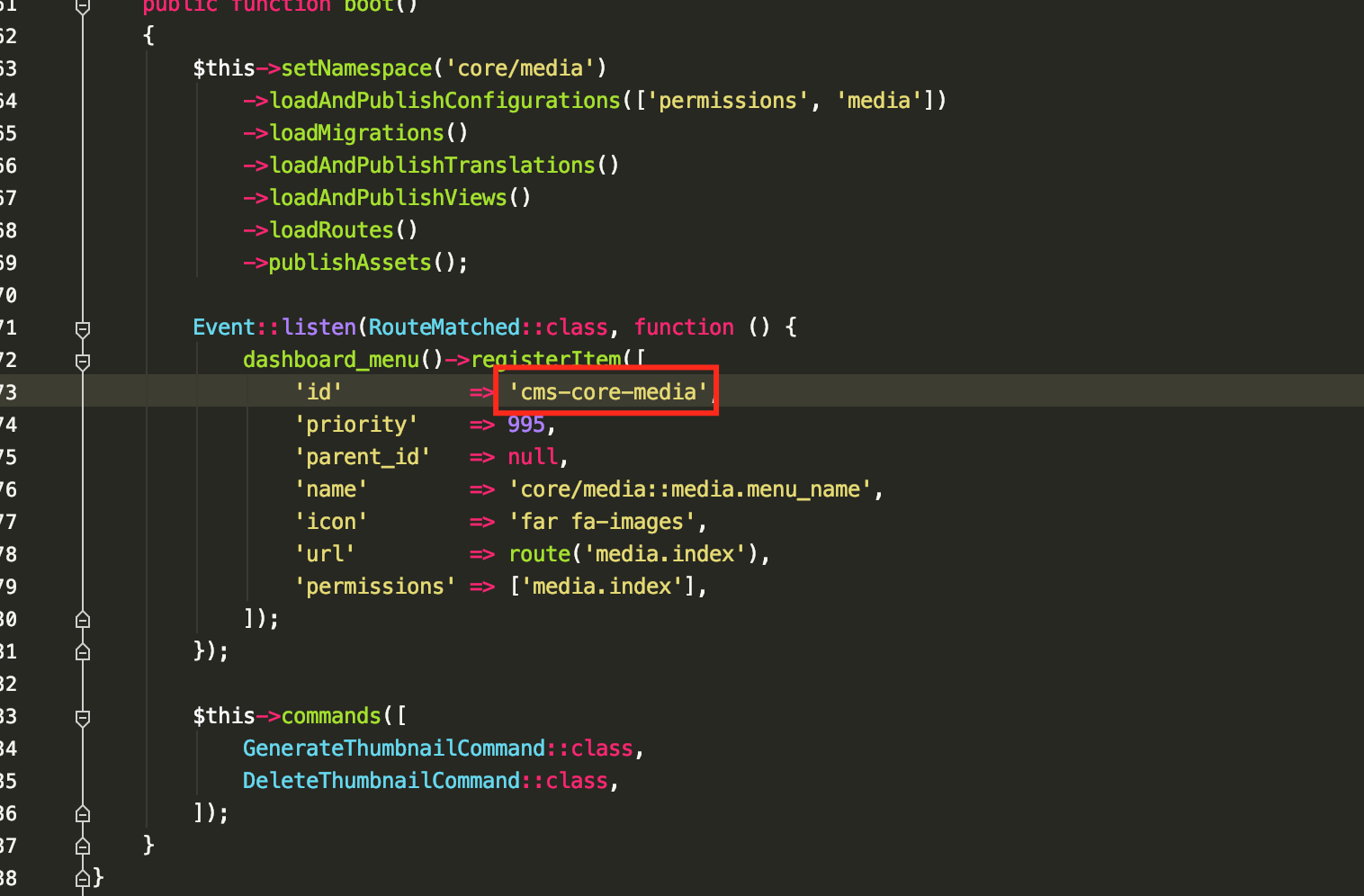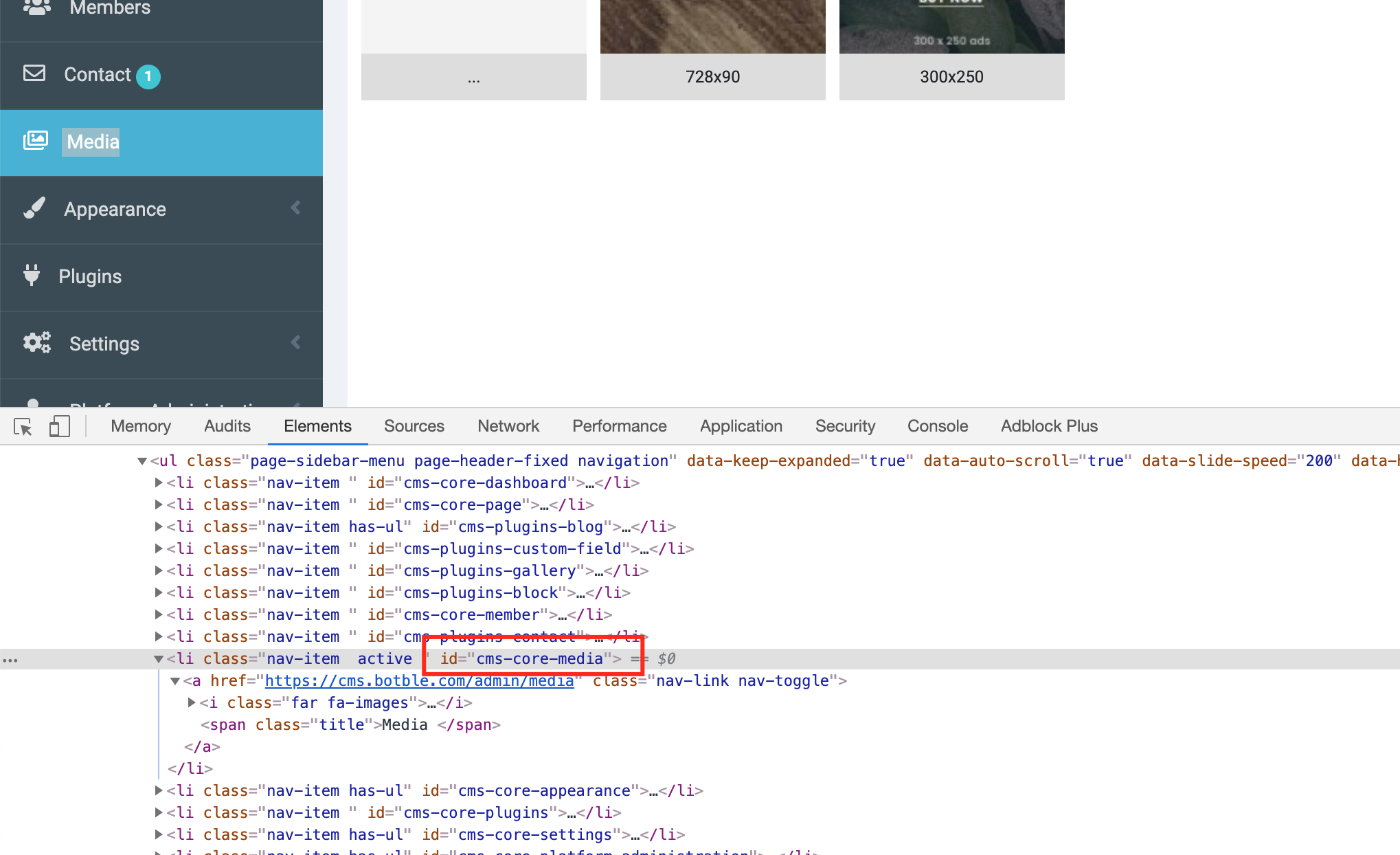Dashboard Menu
Introduction
The DashboardMenu class in Botble CMS provides a powerful way to manage the admin dashboard menu. It allows you to register, remove, and organize menu items with a fluent API. The menu system supports hierarchical structures, permissions, and multiple menu groups.
Menu Architecture
The dashboard menu system consists of two main classes:
- DashboardMenu: The main class that manages menu items, groups, and rendering.
- DashboardMenuItem: A builder class for creating menu items with a fluent API.
Menu items are stored in memory and can be cached for better performance. Each menu item has properties like ID, name, icon, URL, permissions, and parent-child relationships.
Menu Groups
Botble CMS supports multiple menu groups, allowing you to have different menus for different sections of your application. The default group is 'admin', which is used for the main admin dashboard.
// Working with the default admin menu
DashboardMenu::default()->...
// Working with a custom menu group
DashboardMenu::for('member')->...
// Using the group method for temporary context
DashboardMenu::group('custom-group', function ($menu) {
// Register items for this group
});Registering Menu Items
Using DashboardMenuItem (Recommended)
The recommended way to register menu items is using the DashboardMenuItem class with the beforeRetrieving method:
use Botble\Base\Facades\DashboardMenu;
use Botble\Base\Supports\DashboardMenuItem;
DashboardMenu::default()->beforeRetrieving(function () {
DashboardMenu::make()
->registerItem(
DashboardMenuItem::make()
->id('cms-plugins-your-plugin')
->priority(99)
->parentId(null) // or parent ID for submenu items
->name('plugins/your-plugin::your-plugin.name')
->icon('ti ti-package')
->route('your-plugin.index')
->permissions(['your-plugin.index'])
);
});Using Array Syntax
You can also register menu items using an array:
DashboardMenu::default()->beforeRetrieving(function () {
DashboardMenu::make()->registerItem([
'id' => 'cms-plugins-your-plugin',
'priority' => 99,
'parent_id' => null,
'name' => 'plugins/your-plugin::your-plugin.name',
'icon' => 'ti ti-package',
'route' => 'your-plugin.index',
'permissions' => ['your-plugin.index'],
]);
});Menu Item Properties
- id: Unique identifier for the menu item (required)
- priority: Order priority (lower numbers appear first)
- parent_id: ID of the parent menu item (null for top-level items)
- name: Display name (preferably a translation key)
- icon: Icon class (Tabler icons or Font Awesome)
- url: Direct URL for the menu item
- route: Route name (will be converted to URL)
- permissions: Required permissions to view this menu item
Creating Submenus
To create a submenu, set the parentId to the ID of the parent menu item:
// Parent menu
DashboardMenuItem::make()
->id('cms-plugins-your-plugin')
->name('Your Plugin')
->icon('ti ti-package');
// Submenu items
DashboardMenuItem::make()
->id('cms-plugins-your-plugin-items')
->parentId('cms-plugins-your-plugin')
->name('Items')
->route('your-plugin.items.index')
->permissions(['your-plugin.items.index']);
DashboardMenuItem::make()
->id('cms-plugins-your-plugin-settings')
->parentId('cms-plugins-your-plugin')
->name('Settings')
->route('your-plugin.settings')
->permissions(['your-plugin.settings']);Removing Menu Items
Removing a Single Item
DashboardMenu::default()->beforeRetrieving(function () {
DashboardMenu::make()->removeItem('cms-core-media');
});Removing Multiple Items
DashboardMenu::default()->beforeRetrieving(function () {
DashboardMenu::make()->removeItem([
'cms-core-media',
'cms-core-plugins',
]);
});Removing a Submenu Item
When removing a submenu item, you only need to specify its ID:
DashboardMenu::default()->beforeRetrieving(function () {
DashboardMenu::make()->removeItem('cms-core-system-information');
});Preventing Access to Removed Menu Items
When you remove a menu item, the corresponding URL may still be accessible. To prevent access, you should also check the current route:
DashboardMenu::default()->beforeRetrieving(function () {
DashboardMenu::make()->removeItem('cms-core-system-information');
});
if (in_array(Route::currentRouteName(), ['system.info'])) {
abort(403);
}Advanced Usage
Menu Hooks
The dashboard menu system provides hooks for customizing the menu:
// Execute code before retrieving the menu
DashboardMenu::default()->beforeRetrieving(function (DashboardMenu $menu) {
// Register or modify menu items
});
// Execute code after the menu is retrieved
DashboardMenu::default()->afterRetrieved(function (DashboardMenu $menu, Collection $items) {
// Modify the retrieved menu items
});Checking for Menu Items
if (DashboardMenu::default()->hasItem('cms-plugins-your-plugin')) {
// The menu item exists
}Getting Menu Items
// Get all menu items
$allItems = DashboardMenu::default()->getAll();
// Get a specific menu item by ID
$item = DashboardMenu::default()->getItemById('cms-plugins-your-plugin');
// Get all items with a specific parent ID
$childItems = DashboardMenu::default()->getItemsByParentId('cms-plugins-your-plugin');Menu Caching
The dashboard menu can be cached for better performance. The cache is user-specific and respects permissions:
// Clear the menu cache for the current user
DashboardMenu::default()->clearCachesForCurrentUser();
// Clear the menu cache for all users
DashboardMenu::default()->clearCaches();
// Check if the menu is cached
if (DashboardMenu::default()->hasCache()) {
// The menu is cached
}Best Practices
Use Consistent ID Naming: Follow the pattern
cms-plugins-your-pluginfor plugin menu items.Use Translation Keys: Always use translation keys for menu names for better localization.
Set Appropriate Permissions: Ensure menu items have the correct permissions to control visibility.
Use Tabler Icons: Prefer Tabler icons (
ti ti-*) over Font Awesome for consistency with the admin theme.Register in Service Providers: Register menu items in your plugin's service provider's
bootmethod.Use beforeRetrieving: Register menu items using the
beforeRetrievingmethod to ensure proper ordering and caching.
Finding Menu IDs
You can find menu IDs in the source code or by inspecting the HTML in your browser:

Or from browser inspector:

